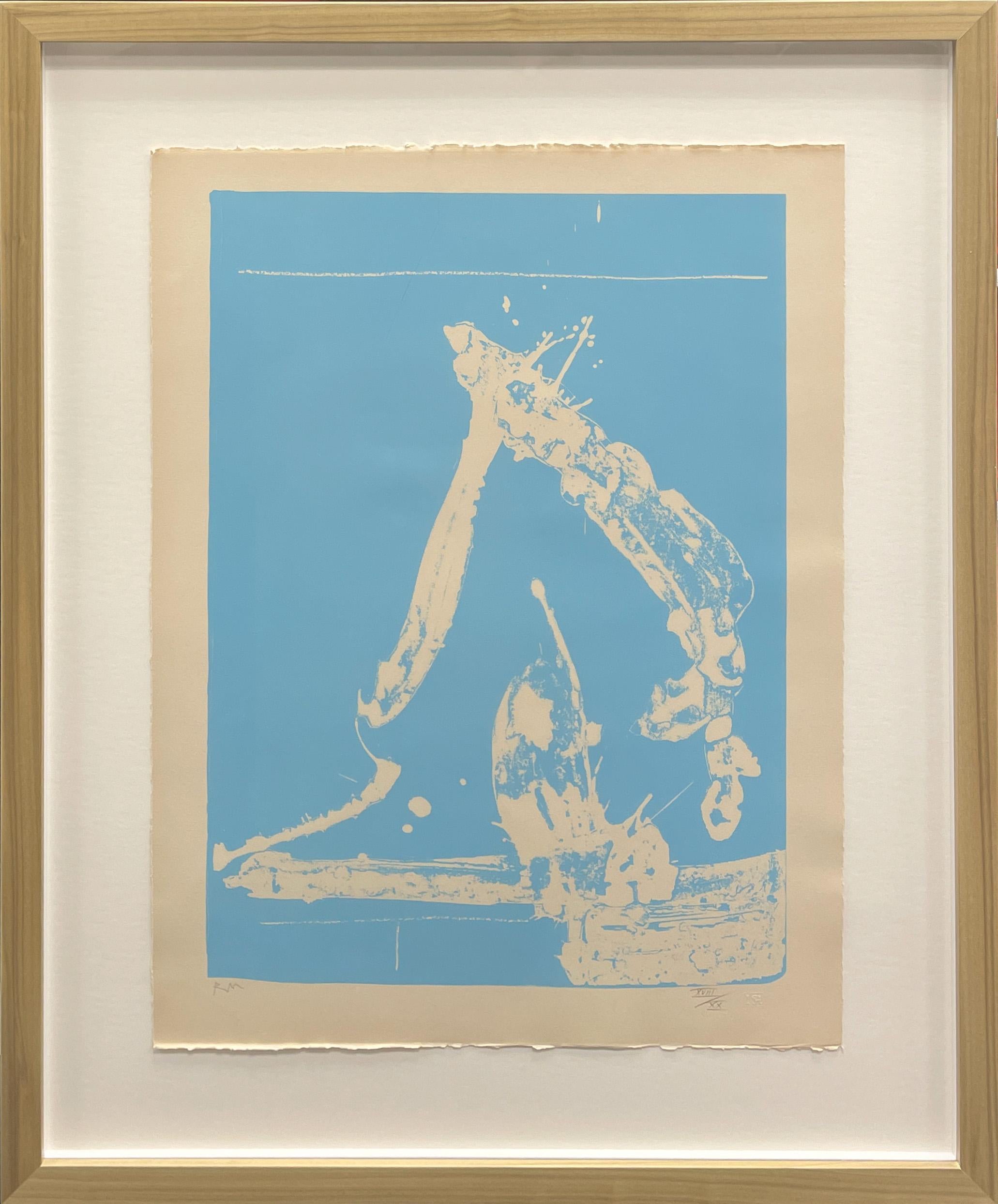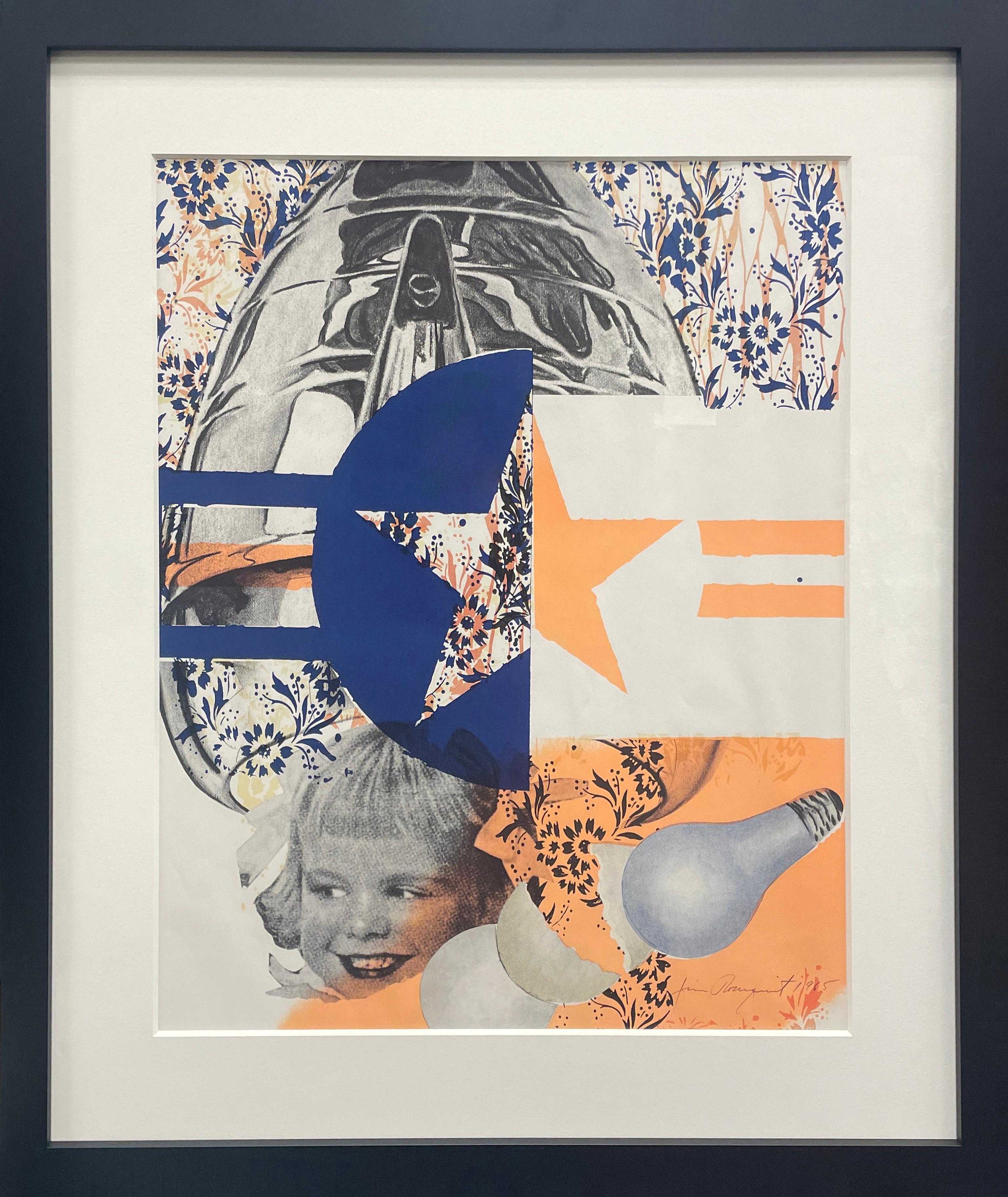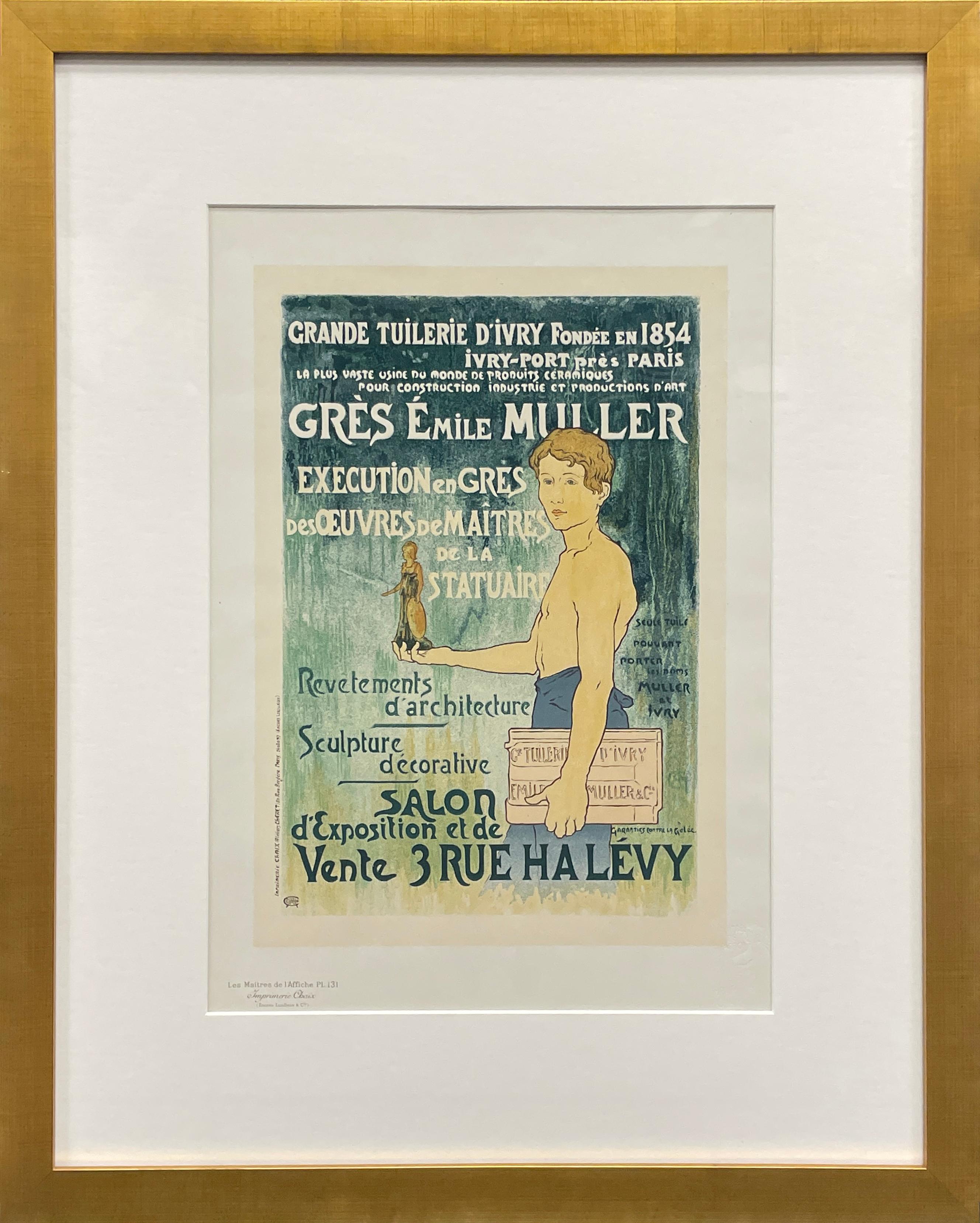Items Similar to "Italien Schweiz (Train), " Original Color Litho Poster signed by Aage Rasmussen
Want more images or videos?
Request additional images or videos from the seller
1 of 9
Aage Rasmussen"Italien Schweiz (Train), " Original Color Litho Poster signed by Aage Rasmussen1951
1951
About the Item
"Italien Schweiz (Train)" is an original color lithograph poster by Aage Rasmussen. It features a train speeding past landmarks of Italy.
39 1/4" x 24 1/4" art
49 1/2" x 33 5/8" frame
Aage Rasmussen(1889-1983) made his breakthrough as a young man, in 1937 when he proposed a poster for DSB: Lyntogsplakaten, which was accepted on the spot. The poster in the worm's eye view shows the track with the forward running express trains, while the old steam train disappears from the track. As the light is seen a speedometer. As well as train speed was changed, corrected Aage Rasmussen poster, as he retained the template itself, but changed trains and speed indication. Aage Rasmussen made since several posters for DSB. Several of them were used as advertising abroad.
Danish Poster Museum has reprinted a number of beautiful posters of Aage Rasmussen as the museum along with Art and inherited rights dertil.Andre posters for such SAS, Maersk, DFDS, the Danish Book Week, Automobile exhibition in the Forum. Aage Rasmussen became the model for many Danish poster artists for generations after him. In 1938 won Aage Rasmussen, a competition to create a new Denmark poster. One of the judges was the great idol of the French poster artist AM Cassandre. The poster was, however, only printed after the war, in 1946. Since Aage Rasmussen made a number byplakater, tourist posters, inter alia, Odense, Svendborg, Herning.
- Creator:Aage Rasmussen (1889 - 1983)
- Creation Year:1951
- Dimensions:Height: 49.5 in (125.73 cm)Width: 33.625 in (85.41 cm)
- Medium:
- Period:
- Condition:
- Gallery Location:Milwaukee, WI
- Reference Number:
About the Seller
4.9
Platinum Seller
These expertly vetted sellers are 1stDibs' most experienced sellers and are rated highest by our customers.
Established in 1966
1stDibs seller since 2017
390 sales on 1stDibs
Typical response time: 1 hour
- ShippingRetrieving quote...Ships From: Milwaukee, WI
- Return PolicyA return for this item may be initiated within 14 days of delivery.
More From This SellerView All
- "Back Cover of "Chagall Lithographe III, " M 577, " an Original Color LithographBy Marc ChagallLocated in Milwaukee, WIThis is the back cover of "Chagall Lithographe III," M 577". It is an original Lithograph by Marc Chagall. This print is a glorious black and red bouquet, most of the foliage is shown by black leaves and stems where as the flowers and blooms are red. Also on the top right one can see a tiny red bird. Image: 12.5 x 10 in Frame: 25.5 x 21.5 in Marc Chagall was born in Liozno, near Vitebsk, now in Belarus. The eldest of nine children in a close-knit Jewish family. His father Khatskl (Zakhar) Shagal, a herring merchant, and his mother, Feige-Ite. This period of his life, described as happy though impoverished, appears in references throughout Chagall's work. The family home on Pokrovskaya Street is now the Marc Chagall Museum. He began studying painting in 1906 with a local artist, Yehuda Pen. In 1907, he moved to St. Petersburg. There he joined the school of the Society of Art Supporters and studied under Nikolai Roerich. It was here that he was exposed to experimental theater and the work of such artists as Gauguin. From 1908-1910 Chagall studied under Leon Bakst at the Zvantseva School of Drawing and Painting. This was a difficult period for Chagall; at the time, Jewish residents were only allowed to live in St. Petersburg with a permit, and the artist was jailed for a brief period for an infringement of this restriction. Despite this, Chagall remained in St. Petersburg until 1910, and regularly visited his home town where, in 1909, he met his future wife, Bella Rosenfeld. After gaining a reputation as an artist, Chagall left St. Petersburg to settle in Paris to be near the burgeoning art community in the Montparnasse district, where he developed friendships with such avant-garde luminaries as Guillaume Apollinaire, Robert Delaunay, and Fernand Léger. In 1914, he returned to Vitebsk and, a year later, married his fiancée, Bella. While in Russia, World War I erupted and, in 1916, the Chagalls had their first child, a daughter named Ida. Chagall became an active participant in the Russian Revolution of 1917. Although the Soviet Ministry of Culture made him a Commissar of Art for the Vitebsk region, where he founded Vitebsk Museum of Modern Art and an art school, he did not fare well politically under the Soviet system. "Chagall was considered a non-person by the Soviets because he was Jewish and a painter whose work did not celebrate the heroics of the Soviet people."[6] He and his wife moved back to Paris in 1922. During this period, Chagall wrote articles, poetry and his memoirs (in Yiddish,) which were published mainly in newspapers (and only posthumously in book-form). Chagall became a French citizen in 1937. With the Nazi occupation of France during World War II and the deportation of Jews, the Chagalls fled Paris, seeking asylum at Villa Air-Bel in Marseille, where the American journalist Varian Fry assisted in their escape from France through Spain and Portugal. In 1941, the Chagalls settled in the United States where he lived until 1948 (his wife Bella died in 1944.) His wife Bella, who appears in many of his paintings, bore him one child, Ida and then died on September 2, 1944. Bella and Ida appeared in many of his early and most famous paintings. In 1945, he began a relationship with his housekeeper Virginia Haggard McNeil, with whom he had a son, David. In the 1950s, they moved to a villa in Provence. Virginia left him in 1952, and Chagall married Valentina Brodsky (whom he called "Vava"). Jewish influence: Chagall had a complex relationship with Judaism. On the one hand, he credited his Russian Jewish cultural background as being crucial to his artistic imagination. But however ambivalent he was about his religion, he could not avoid drawing upon his Jewish past for artistic material. As an adult, he was not a practicing Jew, but through his paintings and stained glass, he continually tried to suggest a more "universal message," using both Jewish and Christian themes...Category
1960s Surrealist Still-life Prints
MaterialsLithograph
- "L'Entree en scene (The Emergence), " Color Lithograph after Rene MagritteBy René MagritteLocated in Milwaukee, WI"L'Entree en scene (The Emergence)" is a color lithograph after a 1961 original piece by Rene Magritte. A transparent bird flies over the ocean. The body of this bird shows through it a clean light sky with fluffy clouds. The view around the bird is instead the dark night, stars shine at the top of the scene. Clouds blow by and the waves are turbulent. Art: 20.25 x 14.25 in Frame: 31.38 x 25.38 in René-François-Ghislain Magritte was born November 21, 1898, in Lessines, Belgium and died on August 15, 1967 in Brussels. He is one of the most important surrealist artists. Through his art, Magritte creates humor and mystery with juxtapositions and shocking irregularities. Some of his hallmark motifs include the bourgeois “little man,” bowler hats, apples, hidden faces, and contradictory texts. René Magritte’s father was a tailor and his mother was a miller. Tragedy struck Magritte’s life when his mother committed suicide when he was only fourteen. Magritte and his two brothers were thereafter raised by their grandmother. Magritte studied at the Brussels Academy of Fine Arts from 1916 to 1918. After graduating he worked as a wallpaper designer and in advertisement. It was during this period that he married Georgette Berger, whom he had known since they were teenagers. In 1926, René Magritte signed a contract with the Brussels Art Gallery, which allowed him to quit his other jobs and focus completely on creating art. A year later he had his first solo show at the Galerie la Centaurie in Brussels. At this show Magritte exhibited what is today thought of as his first surrealist piece, The Lost Jockey, painted in 1926. In this work a jockey and his steed run across a theater stage, curtains parted on either side. Throughout the scene, there are trees with trunks shaped somewhat like chess pawns with musical scores running vertically up their sides and branches sticking out from all angles. Critics did not enjoy this style of art; it was new, different, and took critical thought to understand, but The Lost Jockey was only the first of many surrealist artworks Magritte would paint. Because of the bad press in Brussels, René and Georgette moved to Paris in 1927, with the hope that this center of avant-garde art would bring him success and recognition. In Paris, he was able to become friends with many other surrealists, including André Breton and Paul Éluard. They were able to learn from and inspire one another, pushing the Surrealist movement further forward. It was also in Paris that Magritte decided to add text to some of his pieces, which was one of the elements that made his artwork stand out. In 1929, he painted one of his most famous oil works: The Treachery of Images. This is the eye-catching piece centered on a pipe. Below the pipe is written “Ceci n’est pas un pipe,” which translates to “This is not a pipe.” This simple sentence upset many critics of the time, for of course it was a pipe. Magritte replied that it was not a pipe, but a representation of a pipe. One could not use this oil on canvas as a pipe, to fill it with tobacco and smoke it. Thus, it was not a pipe. In 1930, Magritte and Georgette moved back to Brussels. Though they would travel to his exhibitions elsewhere, their home going forward would always be in Brussels. Magritte had his first American exhibition at the Julien Levy Gallery in New York City in 1936 and his first show in England two years later in 1938 at The London Gallery...Category
2010s Surrealist Landscape Prints
MaterialsLithograph
- Homage a Leonardo d' Vinci (Three Figures Advancing from De La Bataille Vol. I)By Claude WeisbuchLocated in Milwaukee, WIArt: 17" x 23 1/4" Frame: 27 5/8" x 33 7/8" Original color lithograph (VIII/L) Signed lower right. This original Weisbuch lithograph comes from th...Category
1970s Contemporary Figurative Prints
MaterialsLithograph
- "Annette, " by Alberto GiacomettiBy Alberto GiacomettiLocated in Milwaukee, WI"Annette" is an original black and white lithograph by Alberto Giacometti. It depicts the bust of a nude woman in scratchy lines. Annette was Alberto's wife and frequently modeled fo...Category
1960s Minimalist Figurative Prints
MaterialsLithograph
- Homage a Leonard de Vinci-Front. Self-portrait of de VinciBy Claude WeisbuchLocated in Milwaukee, WIThis is an original color lithograph created by Claude Weisbuch. It was designed to promote his show at Vision Nouvelle, a gallery in France. This show in particular was about his Ho...Category
1970s Expressionist Prints and Multiples
MaterialsLithograph, Paper
- Homage A Leonard de Vinci (Portrait of Leonardo) Original lithographBy Claude WeisbuchLocated in Milwaukee, WIOriginal lithograph signed VII/L Art: 23 1/8"x17" Frame: 32 3/4"x26 5/8 Signed and number lower margin. Claude Weisbuch was born in Thionville, France in 1927 and was a pupil at L' ...Category
1970s Prints and Multiples
MaterialsLithograph
You May Also Like
- Architectural StudyBy Ettore SottsassLocated in Greding, DELarge format lithograph with architectural study, partly coloured. Signed at lower right. Edition 65/100(?).Category
Late 20th Century Post-Modern Landscape Prints
MaterialsLithograph
- Sandeman Porto & Sherry – Iconic Original PosterLocated in Zurich, CHThe Don: One of the most recognizable figures in poster history ever, quietly reveling in the simple delights of a glass of ruby port – typically thought of as a horseman, clad in a ...Category
1920s Art Deco Figurative Prints
MaterialsPaper, Lithograph
- Henri Toulouse Lautrec, Original Lithograph 1897By Henri de Toulouse-LautrecLocated in Saint Augustine, FLArtist: Toulouse Lautrec (1864 -1901) French Title: The Chestnut Vendor Medium: Lithograph, Year: 1897 Signature: Signed in Plate (TL) Lower Left Dimensions: 20” x 17” Framed, 11” x 8.5” Unframed A lithograph of a Toulouse Lautrec drawing...Category
Late 19th Century Post-Impressionist Figurative Prints
MaterialsLithograph
- "Untitled" Robert Motherwell from the Portfolio of NineBy Robert MotherwellLocated in Hinsdale, ILRobert Motherwell Untitled (from Portfolio 9), 1967 Lithograph, 1967 22.25 x 17.25 in. (56.52 x 43.82 cm.) Signed; lower left with artist's trademark initials; numbered, Publisher...Category
1960s Abstract Expressionist Abstract Prints
MaterialsLithograph
- F-111 (Castelli Gallery Poster)By James RosenquistLocated in Hinsdale, ILROSENQUIST, JAMES (1933 - 2017) F-111 (Castelli Gallery Poster) Offset Lithograph c. 1965 Signed and dated in pencil along lower edge Sheet Size: 28” x 22”, Fresh ...Category
1960s Pop Art Abstract Prints
MaterialsLithograph, Offset
- "Grande Tuilerie d’Ivry" from Les Maitres de l'AfficheBy Alexandre CharpentierLocated in Hinsdale, ILCHARPENTIER, ALEX (1856 -1909) "Grande Tuilerie d’Ivry" Original lithograph from "Les Maitres de L'Affiche" series Printed by Imprimerie Chaix, Paris Bearing MDL stamp lower right, issue # 33, 1898. Plate #131 Unframed Size: 11 3/8 x 15 3/4”The "Les Maitres de l'Affiche" series was offered as a subscription series to collectors every month for 60 months, from December 1895 through November 1900. The "Maitres de l'Affiche," were issued as separate numbered sheets, referred to as "plates". They were numbered, with the printers name "Imprimerie Chaix," in the margin at the bottom left hand corner, "PL.1" to "PL.240." In the margin at the bottom right hand corner of each, is a blind embossed stamp from a design of Cheret's. The smaller format and the fact the "Maitres" were a paid subscription series, allowed Imprimerie Chaix to use the latest state of the art printing techniques, not normally used in the large format posters due to cost. A very high quality of paper was used, where as the large format posters were printed on lesser quality newsprint, due to cost and a short expected life span. This explains why the quality of the printing, in the "Maitres de l'Affiche," usually far exceeds that of their larger counterparts. The text reads "Great Tileworks of Ivry, founded in 1854, Ivry-Port near Paris; the largest ceramics factory in the world for building, industry and art productions; Emille Muller stoneware; execution of works by masters of statuary; architectural facings; decorative sculpture; showroom and salesroom, 3 rue Halevy; the only tile able to bear the names Muller and Ivry; (tiles) guaranteed against frost" Given the commission for an extremely text heavy poster, the artist executes a masterful design. The angelic young boy holds the wares of this famous ceramics factory, against an abstract background awash in organic green hues. The handling of the immense text that flows from top to bottom in every available space shows great artistic skill, as the overall beauty of the design is intact. In 1989 the Metropolitan Museum of art acquired a stoneware plaque...Category
1890s Art Nouveau Figurative Prints
MaterialsLithograph
Recently Viewed
View AllMore Ways To Browse
Model Trains
Model Train
Old French Posters
Denmark Book
Retro War Posters Art Posters
Poster Denmark
Train Lithograph
Retro Italian Art Posters
Framed Exhibition Poster Original
Litho Prints
Vintage Litho
Tourist Sign
Denmark Vintage Poster
Vintage Litho Prints
Italian Advertising Posters
Advertising Poster Italy
Exhibition Poster 1983
French Train Posters




